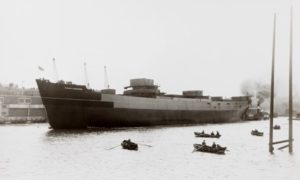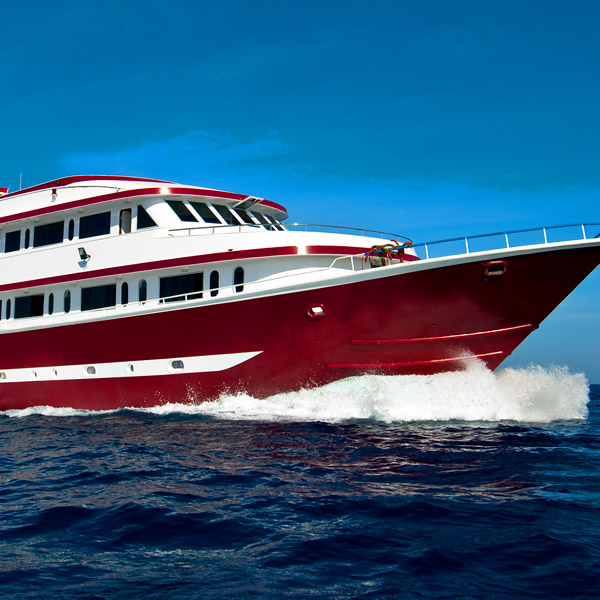The Thistlegorm was launched in June, 1940. She was over 125m long and displaced 4,898 gross tonnes. She was powered by a three-cylinder steam engine that allowed for 365 nominal horsepower. She was one of six Royal Navy "Thistle" ships owned and operated by the Albyn Line. (Thistle is the national flower of Scotland.) She was designated for war duties.
Location:
27 49' 03" N, 33 55' 14"E
Access:
Northeast of Shag Rock, Shaab Ali
Minimum Depth to Wreck:
10m (at bridge)
Maximum Depth to Seabed:
31m (railway engine)
Average Visibility:
25-30m
THE STORY OF THE SINKING:
 In May, 1941 the Thistlegorm was being loaded with war supplies in her home port of Glasgow. She was to carry huge amounts and a wide array of military cargo including land mines, shells, ammunition, weapons, trucks, armoured cars, motorcycles, trailers, vehicle and aircraft spare parts, radios, rubber boots and a whole lot more. There were also a couple of railway engines, tenders and water carriers for the Egyptian Railways. She joined a large convoy and headed for Alexandria.
In May, 1941 the Thistlegorm was being loaded with war supplies in her home port of Glasgow. She was to carry huge amounts and a wide array of military cargo including land mines, shells, ammunition, weapons, trucks, armoured cars, motorcycles, trailers, vehicle and aircraft spare parts, radios, rubber boots and a whole lot more. There were also a couple of railway engines, tenders and water carriers for the Egyptian Railways. She joined a large convoy and headed for Alexandria.
The Axis Forces having occupied almost all of the northern Mediterranean coastline, the convoy followed the safer route to Alexandria which was via South Africa. After sailing north along Africa’s eastern coasts, the convoy arrived in the Red Sea.
When arriving at the entrance to the Gulf of Suez, Thistlegorm was assigned “safe anchorage” and was to wait for further information. They settled in to wait for clearance to proceed through the channel to Alexandria.
The length of wait was dependent on several factors such as aircraft activity, cargo priority and the time the vessels had been waiting already. Thanks to two vessels colliding in the gulf and virtually blocking the way through, Thistlegorm was forced to wait two weeks, standing idle.
German night-flying aircrafts were alerted to possible large-sized vessels in the Red Sea. On October 5, 1941 at about 11pm two aircrafts left their base in Crete and headed for the Egyptian coast. Their mission was to seek and destroy.
Just as their fuel levels were getting to a critical low and they thought their mission was fruitless, the Germans noticed a ship at anchor. One of the pilots dipped his plane low and approached the Thistlegorm, dropping his bombs right over the bridge. The bombs detonated the ammunition cargo and the explosion ripped the ship open.
The vessel began to sink quickly and the crew speedily abandoned the ship. The Thistlegorm sank at 1:30am on October 6, 1941. In all, 9 people lost their lives.
DIVING AT THE WRECK:
 The Thislegorm was initially discovered by the legendary Jacques-Yves Cousteau in 1956. She sits on the seabed at 28m in an upright sailing position. The very top of the structure is only 12m from the water surface. She is one of the most sought-out wrecks in the world and with reason.
The Thislegorm was initially discovered by the legendary Jacques-Yves Cousteau in 1956. She sits on the seabed at 28m in an upright sailing position. The very top of the structure is only 12m from the water surface. She is one of the most sought-out wrecks in the world and with reason.
The holds are still laden with cargo. Divers can discover the tons of equipment such as jeeps, trucks, tires, motorcycles and alike and easily imagine the life onboard this awesome vessel. Around the vessel there also items that were ejected from the cargo hull following the tremendous explosion. There are tanks, towing equipment, boxed ammunition and weapons.
Access is easy through the blasted-out bridge area. The crumpled decking folding out as an open tin can is still as it had been after the explosion. The image tells of a devastating event. Vehicles are parked in the hold as if waiting to be unloaded. On the starboard side besides the vehicles, other items can be found like small arms and weapons. On the stern two deck-mounted guns are still in place and are best viewed from below.
Usually there is a current but it can get quite strong coming in from the north. Groupers, jackfish, tuna and the occasional black-tip shark are just a few of the larger marine life visiting this place. The usual reef fish and creatures are also present and provide a nice distraction from the wreck.

